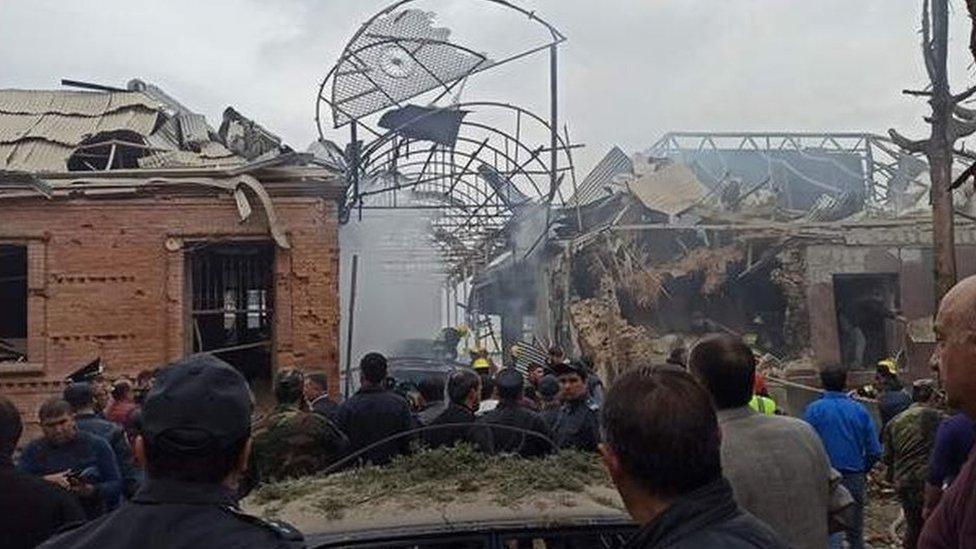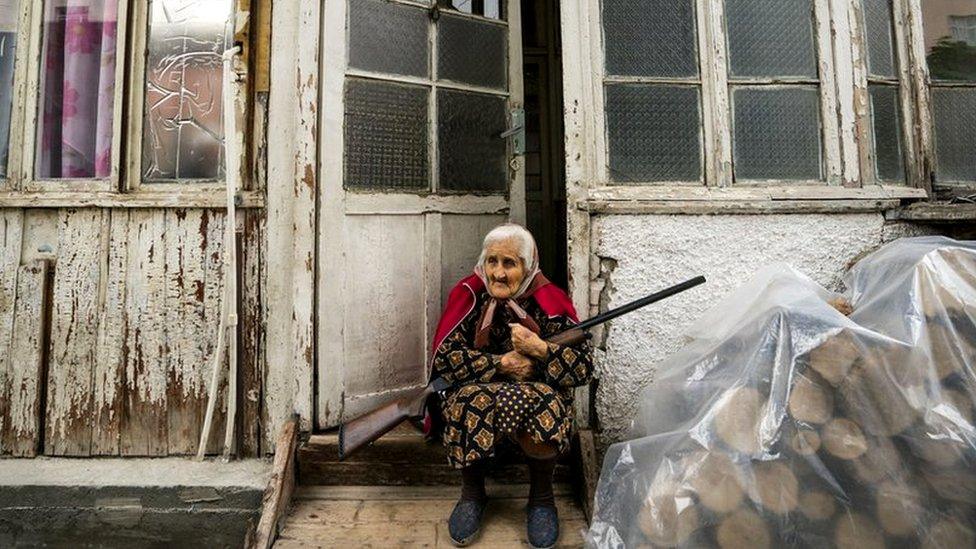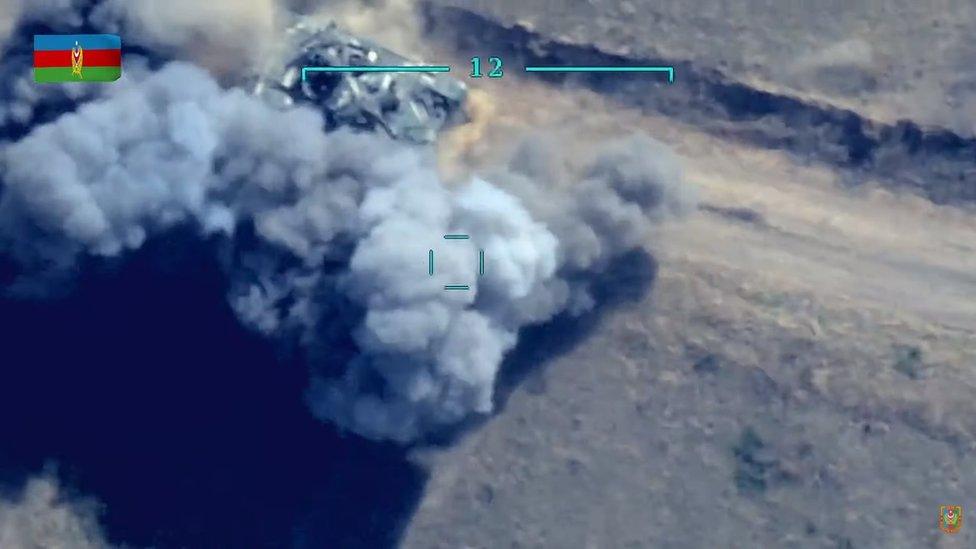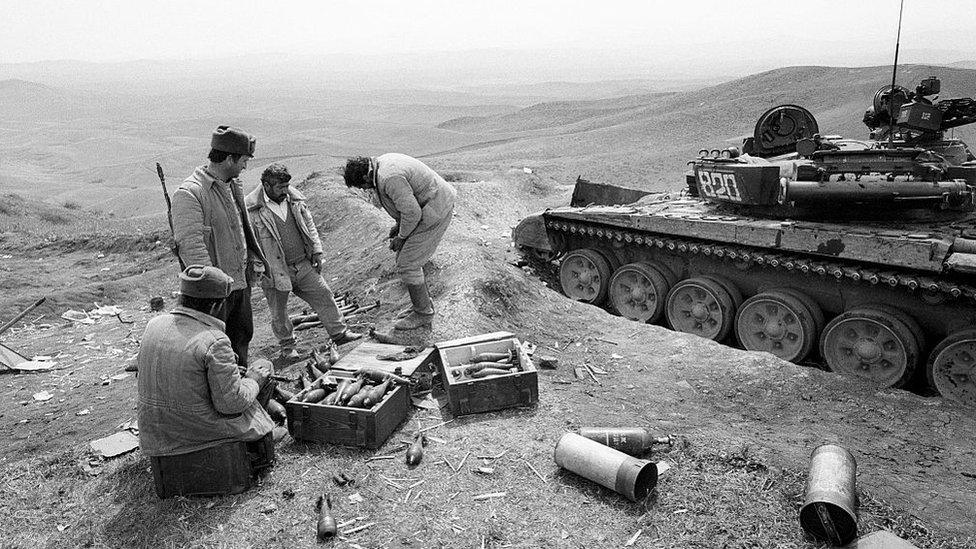Nagorno-Karabakh: Armenia accuses Azerbaijan of targeting cathedral
- Published

Broken pews and rubble were strewn around the inside of the Holy Saviour Cathedral in Shusha
Armenia has accused Azerbaijan of targeting a historic cathedral in Nagorno-Karabakh shelled during fighting over the disputed region.
Photos showed damage to both the interior and exterior of the Holy Saviour Cathedral in Shusha city.
More than 300 people have died and thousands displaced since the latest fighting broke out on 27 September.
International monitors from the US, Russia and France have begun efforts to try and end the violence.
They are meeting the Azeri foreign minister in Geneva on Thursday. The Armenian foreign minister is due to meet his Russian counterpart in Moscow on Monday.
Nagorno-Karabakh is officially part of Azerbaijan but run by ethnic Armenians. The current fighting is the worst seen in decades, and both sides have blamed each other for the violence.
What is the latest from Nagorno-Karabakh?
Ghazanchetsots (Holy Saviour) Cathedral, an iconic site for the Armenian Apostolic Church, suffered serious damage, foreign journalists reported from Shusha (known as Shushi in Armenian).
Allow X content?
This article contains content provided by X. We ask for your permission before anything is loaded, as they may be using cookies and other technologies. You may want to read X’s cookie policy, external and privacy policy, external before accepting. To view this content choose ‘accept and continue’.

A section of the roof collapsed, rubble was strewn on the floor, pews were knocked over and the interior was covered in dust from parts of the building's limestone walls that had been hit.
A local resident, Simeon, told AFP news agency: "There is no military, nothing strategic here, how can you target a church? It is a very important cathedral for Armenians. God will be the judge."
Armenia's defence ministry spokesman, Artsrun Hovhannisyan, accused "enemy Azerbaijan" of targeting the cathedral.
Also on Thursday, Armenia announced it had dismissed the head of its National Security Service but did not give a reason for it.
For its part, Azerbaijan said its second-largest city, Ganja, and the region of Goranboy had been shelled by Armenian forces, killing at least one civilian.
What is the regional reaction to the fighting?
Iran, which borders Armenia and Azerbaijan, warned on Wednesday that the fighting had the potential to become a "regional war".
"Peace is the basis of our work and we hope to restore stability to the region in a peaceful way," President Rouhani said.
But he also said it was "totally unacceptable" for any stray shells and missiles to land on Iranian soil, following reports that shells had landed on Iranian border villages.


Russian President Vladimir Putin also called for an end to the fighting, which he described as a "tragedy".
"We are very concerned," he said in a televised interview. "We hope that this conflict will end in the very near future. People are dying [and] there are heavy losses on both sides."
Russia is part of a military alliance with Armenia and has a military base in the country. However, it also has close ties to the government of Azerbaijan.
How did the latest fighting escalate?
Armenia and Azerbaijan went to war over Nagorno-Karabakh in 1988-94, eventually declaring a ceasefire. However, they have never reached a settlement over the dispute and tensions between the two have long simmered.
The two former Soviet republics have blamed each other for the latest escalation, which has seen the heaviest fighting since 2016 when at least 200 people were killed in clashes.
Under fire in Nagorno-Karabakh
The clashes have displaced half of Nagorno-Karabakh's population - about 70,000 people - the region's human rights ombudsman Artak Beglaryan said.
The main city in Nagorno-Karabakh, Stepanakert, has been hit by several days of shelling. Residents have been taking shelter in basements and much of the city has been left without power.
There are fears the actual death toll among military forces from all sides as well as civilians could be much higher, as casualty claims have not been independently verified.

Nagorno-Karabakh - key facts
A mountainous region of about 4,400 sq km (1,700 sq miles)
Traditionally inhabited by Christian Armenians and Muslim Turks
In Soviet times, it became an autonomous region within the republic of Azerbaijan
Internationally recognised as part of Azerbaijan, but majority of population is ethnic Armenian
Self-proclaimed authorities are not recognised by any UN member, including Armenia
An estimated one million people displaced by war in 1988-94, and about 30,000 killed
Separatist forces captured some extra territory around the enclave in Azerbaijan
Stalemate has largely prevailed since a 1994 ceasefire
Turkey openly supports Azerbaijan
Russia has a military base in Armenia
Ros Atkins explains why fighting over the disputed region of Nagorno-Karabakh continues to intensify
- Published4 October 2020

- Published5 October 2020

- Published30 September 2020

- Published12 November 2020
